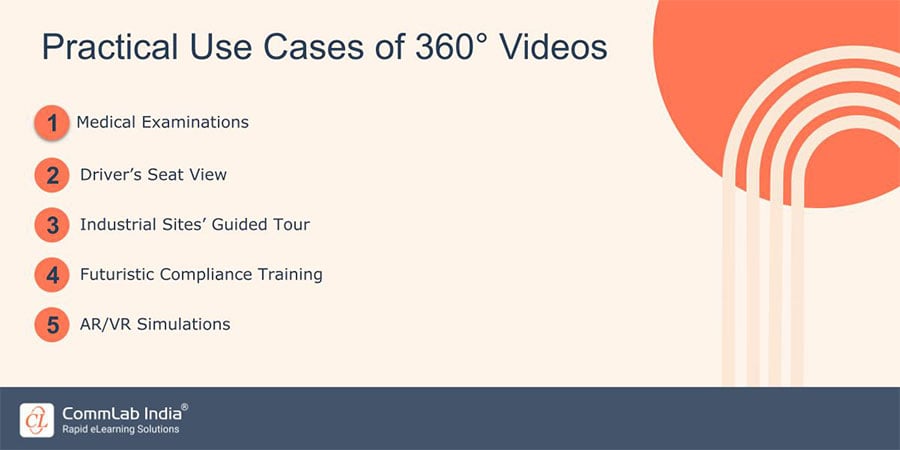How eLearning Authoring Tools Ensure Seamless Video-Based Learning + Popular Video Formats
eLearning authoring tools facilitate effective, seamless video-based learning. Read on to know how along with exploring popular, trending video formats.

Greetings, eLearning enthusiasts! I am here to talk about one of the most exciting and innovative aspects of modern eLearning i.e. video-based learning. And more importantly, how the various features of modern eLearning authoring tools have simplified video-based learning and taken it to the next level.
But before we delve into that, let’s take a moment to appreciate the awesomeness of video-based learning. Because let’s face it, learning from a boring textbook or a lecture can be as interesting as watching paint dry. But with video-based learning, you can bring learning to life and make it as engaging as watching a blockbuster movie.
It’s the perfect way to capture the attention of learners and keep them engaged throughout the learning process.
eLearning Authoring Tools Make Video-Based Learning Hassle-Free!
Here are a few things you can do with the help of these tools –
- Create interactive videos
- Design personalized learning paths
- Generate mobile-friendly videos
- Develop microlearning videos
Read on to explore the various video formats that are popular among today’s generation
How eLearning Authoring Tools Make Video-Based Learning Seamless
1. Create Interactive Videos
First up, we have the ability to create interactive videos. With the help of eLearning authoring tools, you can create videos that allow learners to interact with the content. For example, you can add quizzes or polls to your videos, which not only make the learning experience more engaging but also help learners retain the information better. Check out the short video below to explore a few strategies to enhance learner engagement.
But that’s not all, folks! You can also add clickable hotspots to your videos, which allow learners to explore different parts of the video and get more information on specific topics. And if that’s not cool enough, tools like Lectora and Adobe Captivate can help you add branching scenarios to your videos, which allow learners to make decisions and see the consequences of their actions in real-time.
2. Design Personalized Learning Paths
Next up, we have the option to create personalized learning paths. With modern eLearning authoring tools, you can create videos that are tailored to the needs of individual learners. For example, you can create different versions of the same video with varying levels of complexity, so learners can choose the version that best suits their learning style and level of expertise.
But wait, there’s more! You can also use learning analytics data to create personalized learning paths. For example, if a learner consistently struggles with a particular concept, eLearning authoring tools like Gomo can automatically suggest videos or resources that will help them master that concept. It’s like having a personal learning mentor but without the expensive price tag!
→ Download Now: Authoring Tool Finder
3. Generate Mobile-Friendly Videos
Another feature that has simplified video-based learning is the ability to create mobile-friendly videos. Let’s face it, we live in a world where people are constantly on the go and mobile learning is the new normal. So, it’s essential to make sure that your learning materials are accessible on mobile devices. With modern eLearning authoring tools, you can create videos that are optimized for mobile devices, so learners can access them anytime, anywhere, and on any device.
But it’s not just about making videos mobile-friendly. With modern eLearning authoring tools like Articulate 360 and dominKnow, you can create responsive videos that adjust to the size of the device screen automatically. In fact, some of them even have separate tools to design responsive content pieces. For example Articulate 360 has Rise 360 and dominKnow has Flow.
So, whether a learner uses a desktop computer or a smartphone, eLearning authoring tools ensure that they still enjoy a seamless learning experience. This takes learning and convenience to the next level!
Along with eLearning authoring tools, rapid eLearning too plays a vital role in facilitating effective, successful learning experience. It ticks the boxes for flexibility, ease of access, learner engagement, as well as cost-effectiveness. Check out the infographic below to understand what rapid eLearning is and how it accelerates success by enabling quick rollout of the training courses without compromising the quality.

4. Develop Microlearning Videos
Last but not the least, eLearning authoring tools help create microlearning videos. Our attention spans are getting shorter and shorter by the day so it’s essential to deliver learning materials in bite-sized chunks that learners can consume quickly and easily.
With eLearning authoring tools, you can create microlearning videos that are short and sweet, but still, pack a punch when it comes to delivering valuable information. And the best part? You can create microlearning videos in a variety of formats, from animated explainer videos to live-action videos, depending on what works best for your learners.
Popular New-Age and Trending Video Formats
- Animated explainer videos: These videos use colorful and engaging animations to explain complex concepts or processes. They’re often used in technical training, software training, or to simplify a topic that might be difficult to understand.
- Live-action videos: Live-action videos use real people or objects to demonstrate a process or explain a concept. They’re often used in soft skills training, such as leadership programs, customer service, or conflict resolution.
- Virtual reality videos: These videos use virtual reality technology to create an immersive learning. Learners can interact with 3D environments and objects, making it an ideal format for training that involves hands-on skills, such as medical procedures, or hazardous work environments.
- Augmented reality videos: Similar to virtual reality videos, augmented reality videos use technology to superimpose digital information over real-world objects. Learners can use their mobile devices to scan a physical object and receive additional information or instructions, making it an ideal format for on-the-job training and interactive simulations.
- 360-degree videos: These videos allow learners to view an entire scene or environment in 360 degrees, providing a more immersive learning experience. They are mainly of 2 types, monoscopic and stereoscopic. They’re often used in training that involves exploring physical space, such as a factory or a laboratory. Here’s a quick glance at practical use cases of 360° videos.

- Gamified videos: Gamified videos use game elements, such as points, badges, or leaderboards, to engage learners and motivate them to complete the training. They’re often used in compliance training or other types of mandatory training.
- Micro animations: These are short, animated clips that are designed to explain a single concept or demonstrate a specific task. They can be incorporated into other types of microlearning videos, such as explainer videos, to provide additional information or emphasis.
As you can see, there are plenty of formats to choose from when it comes to creating videos. By selecting the right format for your content and your learners, you can create effective, engaging, and impactful video-based learning experiences to help learners master new skills and concepts.
Parting Thoughts!
In conclusion, video-based learning has come a long way, thanks to the various features of modern eLearning authoring tools. These tools have simplified the process of creating and delivering engaging and effective video-based learning materials to a great extent. And let’s not forget the importance of humor and fun in learning, which can also be easily incorporated into videos with various multimedia assets available in the eLearning authoring tools’ huge repository.
So, if you’re looking to take your eLearning to the next level, consider incorporating video-based learning into your arsenal. And with the help of modern eLearning authoring tools, you can make your videos more interactive, personalized, mobile-friendly, and engaging than ever before. To choose the perfect authoring tool for you, we have an authoring tool finder. Download now to get started.
Editor’s note: This post was originally published in June 2023 and has been updated for comprehensiveness.





